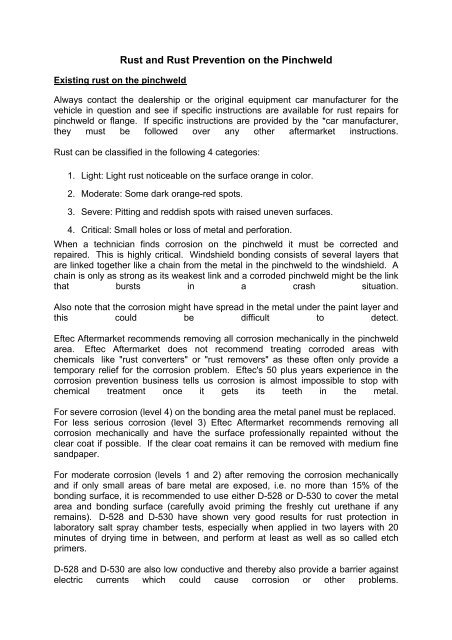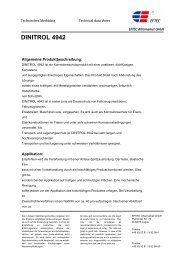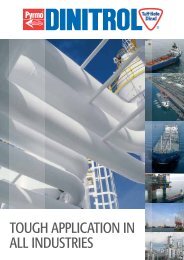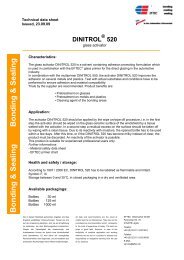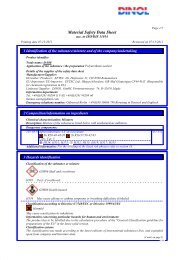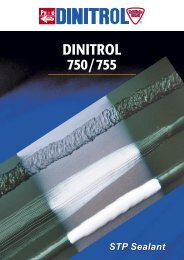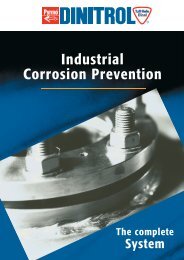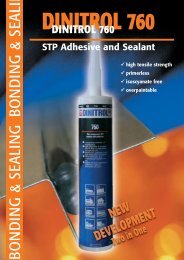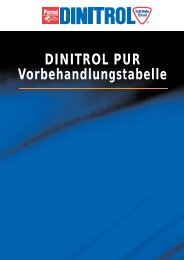Rust and Rust Prevention on the Pinchweld - DINOL
Rust and Rust Prevention on the Pinchweld - DINOL
Rust and Rust Prevention on the Pinchweld - DINOL
You also want an ePaper? Increase the reach of your titles
YUMPU automatically turns print PDFs into web optimized ePapers that Google loves.
<str<strong>on</strong>g>Rust</str<strong>on</strong>g> <str<strong>on</strong>g>and</str<strong>on</strong>g> <str<strong>on</strong>g>Rust</str<strong>on</strong>g> <str<strong>on</strong>g>Preventi<strong>on</strong></str<strong>on</strong>g> <strong>on</strong> <strong>the</strong> <strong>Pinchweld</strong><br />
Existing rust <strong>on</strong> <strong>the</strong> pinchweld<br />
Always c<strong>on</strong>tact <strong>the</strong> dealership or <strong>the</strong> original equipment car manufacturer for <strong>the</strong><br />
vehicle in questi<strong>on</strong> <str<strong>on</strong>g>and</str<strong>on</strong>g> see if specific instructi<strong>on</strong>s are available for rust repairs for<br />
pinchweld or flange. If specific instructi<strong>on</strong>s are provided by <strong>the</strong> *car manufacturer,<br />
<strong>the</strong>y must be followed over any o<strong>the</strong>r aftermarket instructi<strong>on</strong>s.<br />
<str<strong>on</strong>g>Rust</str<strong>on</strong>g> can be classified in <strong>the</strong> following 4 categories:<br />
1. Light: Light rust noticeable <strong>on</strong> <strong>the</strong> surface orange in color.<br />
2. Moderate: Some dark orange-red spots.<br />
3. Severe: Pitting <str<strong>on</strong>g>and</str<strong>on</strong>g> reddish spots with raised uneven surfaces.<br />
4. Critical: Small holes or loss of metal <str<strong>on</strong>g>and</str<strong>on</strong>g> perforati<strong>on</strong>.<br />
When a technician finds corrosi<strong>on</strong> <strong>on</strong> <strong>the</strong> pinchweld it must be corrected <str<strong>on</strong>g>and</str<strong>on</strong>g><br />
repaired. This is highly critical. Windshield b<strong>on</strong>ding c<strong>on</strong>sists of several layers that<br />
are linked toge<strong>the</strong>r like a chain from <strong>the</strong> metal in <strong>the</strong> pinchweld to <strong>the</strong> windshield. A<br />
chain is <strong>on</strong>ly as str<strong>on</strong>g as its weakest link <str<strong>on</strong>g>and</str<strong>on</strong>g> a corroded pinchweld might be <strong>the</strong> link<br />
that bursts in a crash situati<strong>on</strong>.<br />
Also note that <strong>the</strong> corrosi<strong>on</strong> might have spread in <strong>the</strong> metal under <strong>the</strong> paint layer <str<strong>on</strong>g>and</str<strong>on</strong>g><br />
this could be difficult to detect.<br />
Eftec Aftermarket recommends removing all corrosi<strong>on</strong> mechanically in <strong>the</strong> pinchweld<br />
area. Eftec Aftermarket does not recommend treating corroded areas with<br />
chemicals like "rust c<strong>on</strong>verters" or "rust removers" as <strong>the</strong>se often <strong>on</strong>ly provide a<br />
temporary relief for <strong>the</strong> corrosi<strong>on</strong> problem. Eftec's 50 plus years experience in <strong>the</strong><br />
corrosi<strong>on</strong> preventi<strong>on</strong> business tells us corrosi<strong>on</strong> is almost impossible to stop with<br />
chemical treatment <strong>on</strong>ce it gets its teeth in <strong>the</strong> metal.<br />
For severe corrosi<strong>on</strong> (level 4) <strong>on</strong> <strong>the</strong> b<strong>on</strong>ding area <strong>the</strong> metal panel must be replaced.<br />
For less serious corrosi<strong>on</strong> (level 3) Eftec Aftermarket recommends removing all<br />
corrosi<strong>on</strong> mechanically <str<strong>on</strong>g>and</str<strong>on</strong>g> have <strong>the</strong> surface professi<strong>on</strong>ally repainted without <strong>the</strong><br />
clear coat if possible. If <strong>the</strong> clear coat remains it can be removed with medium fine<br />
s<str<strong>on</strong>g>and</str<strong>on</strong>g>paper.<br />
For moderate corrosi<strong>on</strong> (levels 1 <str<strong>on</strong>g>and</str<strong>on</strong>g> 2) after removing <strong>the</strong> corrosi<strong>on</strong> mechanically<br />
<str<strong>on</strong>g>and</str<strong>on</strong>g> if <strong>on</strong>ly small areas of bare metal are exposed, i.e. no more than 15% of <strong>the</strong><br />
b<strong>on</strong>ding surface, it is recommended to use ei<strong>the</strong>r D-528 or D-530 to cover <strong>the</strong> metal<br />
area <str<strong>on</strong>g>and</str<strong>on</strong>g> b<strong>on</strong>ding surface (carefully avoid priming <strong>the</strong> freshly cut urethane if any<br />
remains). D-528 <str<strong>on</strong>g>and</str<strong>on</strong>g> D-530 have shown very good results for rust protecti<strong>on</strong> in<br />
laboratory salt spray chamber tests, especially when applied in two layers with 20<br />
minutes of drying time in between, <str<strong>on</strong>g>and</str<strong>on</strong>g> perform at least as well as so called etch<br />
primers.<br />
D-528 <str<strong>on</strong>g>and</str<strong>on</strong>g> D-530 are also low c<strong>on</strong>ductive <str<strong>on</strong>g>and</str<strong>on</strong>g> <strong>the</strong>reby also provide a barrier against<br />
electric currents which could cause corrosi<strong>on</strong> or o<strong>the</strong>r problems.
Scratches <strong>on</strong> <strong>the</strong> <strong>Pinchweld</strong><br />
Scratches often occur when cutting out a windshield as tools cut through <strong>the</strong> old<br />
urethane. These scratches also should be covered with ei<strong>the</strong>r of two black primers<br />
DINITROL D-528 or D-530.<br />
These primers offer an excellent base for <strong>the</strong> replacement b<strong>on</strong>ding of windshields, as<br />
DINITROL urethane can be applied <strong>on</strong> top of <strong>the</strong> primer. Covering <strong>the</strong> bare metal<br />
spots with DINITROL D-528 <str<strong>on</strong>g>and</str<strong>on</strong>g> D-530 also provides <strong>the</strong> needed corrosi<strong>on</strong><br />
preventi<strong>on</strong>.<br />
* General Motors does have instructi<strong>on</strong>s specific for rust <str<strong>on</strong>g>and</str<strong>on</strong>g> pinchweld flange repairs.<br />
C<strong>on</strong>tact GM at:<br />
General Motors Corporati<strong>on</strong><br />
100 Renaissance Center<br />
P.O. Box 431301<br />
Detroit, MI 48243-7301


